Gary Neal Hansen's Blog, page 16
March 23, 2021
Palm Sunday — Mark 11:1-11
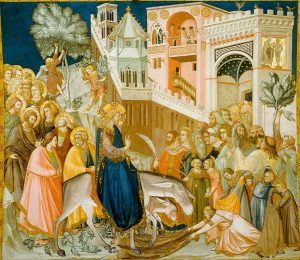
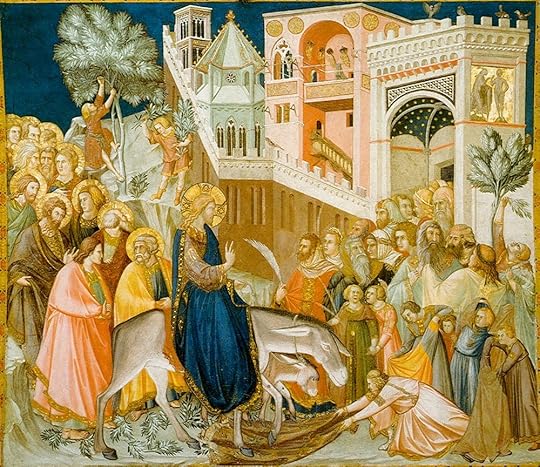 Pietro Lorenzetti, Entry into Jerusalem (public domain)
Pietro Lorenzetti, Entry into Jerusalem (public domain)In year B the lectionary gives four different options for the Gospel reading for Palm Sunday–or “Passion Sunday” as it is called when either the third or fourth option is taken.
First is Mark 11:1-11 — Palm Sunday #1 is Mark’s year in the lectionary and this is Mark’s presentation of Palm Sunday.
Second is John 12:12-16 — Palm Sunday #2 is John’s version. Whenever the lectionary takes a break from the Synoptic Gospel for the year it slips over to John.
Third is Mark 14:1-15:47 — Passion Sunday #1 is Mark’s version of the entire vast Passion narrative, presumably for churches that won’t have Maundy Thursday or Good Friday services and want to make sure their people hear about the Cross.
Fourth is Mark 15:1-39 — Passion Sunday #2 is for churches like the above, but which are too faint of heart for the whole two chapters of the Passion. It’s the Readers’ Digest version.
Personally, and pastorally, I always favor focusing on Palm Sunday. It’s a big day. Spending time on it puts us in sync with the whole of Holy Week. And it puts the Cross in context.
Today I’m looking at Mark’s version.
Palm Sunday — Mark 11:1-11Stories that appear in all three Synoptic Gospels are always fun to compare. The handful of stories that appear in all four Synoptics and John are even more fun.
I tend to hold a mash-up version in my head:
I think about Jesus sending friends to pick up a donkey he has previously arranged to borrow.
Then there’s an impromptu parade, with Jesus riding in on a carpet of coats while the crowd waves palm branches.
The kids sing “Hosanna!” and the grumpy critical people object. Jesus says to lighten up because if they quiet down the stones will take up the song.
But that’s not the version told by Mark — or any one specific Gospel.
Let’s just think about the things Mark has uniquely, or as a minority opinion among the evangelists.
BethanyIn Mark the journey to Jerusalem starts near Bethany. Luke is the only other Gospel to share this detail.
I think of Bethany as something like a home base for Jesus. You can do your own word search to see all the doings that happen in and around that village.
Bethany is where his dear friends Mary, Martha, and Lazarus lived. I imagine it as a place that felt safe and friendly.
Jerusalem, on the other hand, is a place of peril. If you don’t believe me, read the texts for Passion Sunday. Jesus knew what was going to happen in Jerusalem.
The ColtA second detail shared only with Luke is that Mark shows the owners of the colt coming to make sure it wasn’t being stolen.
Matthew is more concerned with this as a fulfillment of OT prophecy, leading him to feature two donkeys. John ignores this bit entirely.
Significant? Not very — though it goes to my sense that Jesus had arranged in advance for the use of the colt.
Leafy BranchesAlong with Matthew, Mark’s crowd cut “leafy branches.” Oddly, Mark says they got them from fields while Matthew, more logically, says trees.
Only in John do they specifically bring palms.
Since it’s Mark’s year in the lectionary maybe we should advertise “Leafy Branch Sunday.”
Or “Leafy Branches and Coats Sunday” since Mark includes those too, as does Matthew.
Next year when Luke’s Gospel is up there won’t be any branches at all. It’ll be “Cloak Sunday.”
Isn’t it funny that we call it “Palm Sunday” when only one Gospel has that detail?
Kingdom of DavidAll the Gospels have the crowd singing “Blessed is he who comes in the name of the Lord,” though Luke says “the king.” I expected them all to say “Hosanna!” but Luke leaves that out.
But even if the song was basically the same for all, Mark includes a special verse:
Blessed is the coming kingdom of our ancestor David!
Hosanna in the highest heaven!
Mark 11:10 NRSV
Matthew also emphasized David as Jesus’ ancestor, but Mark leans into David’s kingdom as something in the future, the messianic kingdom.
That’s something worth pondering as I roll into Holy Week with Mark.
The TempleThe end of this joyful royal journey is the thing most distinctly different in Mark.
Matthew has Jesus jump right into cleansing the temple.Luke has Jesus give a mournful soliloquy over Jerusalem.John finds a bunch of Greeks who love God seeking to see Jesus — which we had in the lectionary last week.In Mark, it’s all different:
Jesus enters Jerusalem.He looks around at the temple.And he calls it a day.He heads back to Bethany for the night.This, I suspect, is the most significant detail in Mark’s version.
Some thoughtsThe core story is, of course, the main thing, even if you have a blurry version swimming in your head like I do, with a mixture of details from all the Gospels.
This is the Sunday that commemorates Jesus riding on a donkey, fulfilling Zechariah’s prophecy. This is the scene that shows the disciples and the crowd giving Jesus the royal welcome he deserves. This is the scene that hammers home to us that the Jesus who faces the Passion is the rightful heir of David’s kingdom, the Messiah.But since I’m meditating on Mark’s version, it is worth noting his specific and unusual details.
First, the direction of Jesus’ journey in Holy Week is from Bethany to Jerusalem. That is, he travels from the familiar to the unfamiliar, from comfort to pain, from a circle of friends to abandonment, from safety to utter risk and incalculable cost.
He did it, as another New Testament writer put it “for the joy set before him.” But it wasn’t joyful in the moment. Joy came only after.
And that kind of journey is, quite often, ours too, as we follow him. Whether in the particular journeys we take in obvious mission and service, or in the very personal challenges we face that the world never sees, we move from safety into risk.
And Jesus has already gone that journey before us.
Jesus travels that road with us today.
Second, we can see in Mark, and only in Mark, that Jesus enjoyed a good piece of theatre.
He set it up in advance. In he rode on the donkey. He allowed them to make a carpet of clothing and wave branches and sing a royal song. And when he got there, it was done. He turned around and went home.The rest of Holy Week is filled with other things:
Teaching, prayer, feasting, fellowship.Abandonment, accusation, torture, death.But on Palm Sunday? Holy drama.
And we Protestants could learn a thing or two from that. We don’t really do drama that well.
My favorite Palm Sunday drama experience was at Beaches Presbyterian Church in Toronto one year. The whole congregation took instruments (including lots of drums and cymbals and shakers) and we paraded around the entire neighborhood. We waved palms. We sang hymns. We raised banners. We banged drums.
Alas, nobody laid down a carpet of coats. The dry cleaning bill would have been sky high.
It’s a perfect bit of Palm Sunday drama for a pandemic. It’s outdoors. You can sing!
Just don’t forget to wear your mask.
++++++++++++
This year Mark is the main Gospel in the Revised Common Lectionary. Want a great way to creatively engage with each Sunday’s text? Want something to keep your kids on-topic during the sermon on Sunday? Try my Illuminate-You-Own Gospel of Mark. Each story is on a page of its own, with a blank facing page for doodles, prayers, sermon notes, or journal entries. Click the image below to check it out on Amazon. (It’s an affiliate link.)
[image error]The post Palm Sunday — Mark 11:1-11 appeared first on Gary Neal Hansen.
March 18, 2021
Breathe: A Child’s Guide to Ascension, Pentecost and the Growing Time — A new book by Laura Alary
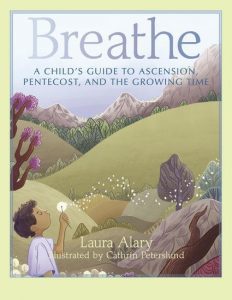
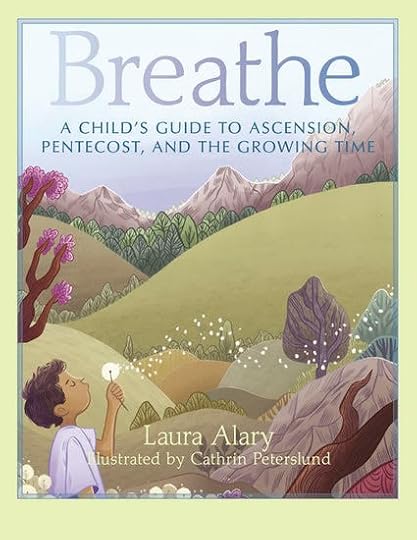 See it on Amazon (affiliate link)Breathe, by Laura Alary
See it on Amazon (affiliate link)Breathe, by Laura Alary Laura Alary
Laura AlaryMy friend Laura Alary has a lovely new book coming out: Breathe: A Child’s Guide to Ascension, Pentecost and the Growing Time (Paraclete Press, 2021). It is designed as a children’s book, but it would be so good for grown-ups too. Don’t miss out just because you don’t have kids around to read it to.
I’ve written about Laura’s work before. This new book makes a Church year trilogy of sorts, following on her Look! A Child’s Guide to Advent and Christmas and Make Room: A Child’s Guide to Lent and Easter.
Laura has a gentle storytelling style, growing from her work with children in churches, as well as from being a mom. And she has a solid academic background, including a Ph.D. in New Testament.
The book takes kids into two great, but sometimes neglected, holy days of the Christian calendar, Ascension and Pentecost. And she does something very unusual by giving thoughtful consideration to the great swath of “ordinary time.” She reframes it nicely as “growing time.”
How often have you heard anything meaningful or useful about “ordinary time”? Here’s your chance.
Her focus alternates between poetically retelling the relevant biblical stories, and discussing the life of faith today.
She reminds us of events that bring up the same emotions as the biblical scenes. She notices how the cycles of nature echo the events of the Church’s seasons. She reflects on things she, her family, and her church do to live into the events of the Christian year.It is all inviting, warm, and lovely. One thing I love about Laura’s books is that they are so wisely real.
This is in contrast to so many Christian books for kids. They often come across either as cloyingly sweet, or they try to drive home a very narrow (and complex) slice of Christian teaching. They end up unpleasantly teachy and preachy.
Laura’s exploration of living the Church’s year instead seem like they show real people nurturing a real faith.
The illustrations by Cathrin Peterslund capture the mood well. In the images of today she shows an admirably wide range of people in terms of ages, races, etc.
Still, I think a couple of the illustrations of Bible passages missed a key mark.
An image of the resurrected Christ accompanies a text about disciples wanting to cling to him. In the picture, all the disciples are male. Scripture most explicitly records this as part of a conversation between Jesus and a female disciple, Mary Magdalene (John 20:17)
The images of the gathered disciples at Pentecost also are all male. The text does not specifically state that those present were all male. Nor does it say the women disciples were there with them. But why assume that they were absent?
Don’t let my critiques of two illustrations turn you away from this winsome invitation to the abiding usefulness and relevance of the Christian calendar.
I don’t know of anything else like it. And our kids really need our help in finding ways to full and growing faith.
Breathe: A Child’s Guide to Ascension, Pentecost and the Growing Time is available for pre-order on Amazon. It’s in both print and Kindle. Order your copy now, and it should reach you April 13.
++++++++++++
Would you do me a favor? Click on one of the sharing buttons below so your friends on Facebook, Twitter, LinkedIn, or Pinterest can enjoy this meditation. Thanks!
The post Breathe: A Child’s Guide to Ascension, Pentecost and the Growing Time — A new book by Laura Alary appeared first on Gary Neal Hansen.
March 17, 2021
We Want to See Jesus — John 12:20-33


The Gospel text for the 5th Sunday of Lent is John 12:20-33, when some Greeks show up and say “We want to see Jesus.” It is a fascinating story, with surprising twists and turns, each of which merits meditation.
“Unless a grain of wheat falls into the earth and dies…”The moment that always sticks out to me is right in the middle. In context it sounds like a non-sequitur: Andrew and Philip are bringing some Greeks to meet Jesus and as soon as they come he starts in on one of the teaching times so typical of John’s Gospel:
Very truly, I tell you,
unless a grain of wheat falls into the earth and dies,
it remains just a single grain;
but if it dies,
it bears much fruit.”
John 12:24 NRSV
However, the reason this looms large for me has nothing to do with the context. It throws me back to high school memories.
I was newly blossoming in faith, and a friend had gotten me involved in a thriving Pentecostal church. It was The Place To Be for Christian kids on Saturday nights, for a cool worship service and engaging Bible teaching. It was altogether a breath of fresh air.
My friend’s whole family went to that church, and he got me involved in his early Sunday morning small group Bible study. There were maybe four of five kids and a very sincere and kind grown up leader. I’m pretty sure there were always donuts.
I was excited to dig more deeply into the Bible. I’d read the New Testament and knew I wanted to follow Jesus. I wanted to up my game.
One Sunday morning we were in this passage.
I had a question about the text:
But when a seed is put in the ground, it doesn’t actually DIE, does it?
The very kind and committed adult leader looked a bit shocked.
Well, you know who said it, don’t you?
And that was supposed to settle my question. If Jesus said the seed dies, then that simply had to be true.
Even if it wasn’t.
What Jesus said was true. But he wasn’t making a scientific point about botany. He was using what appeared to happen to the seed as a metaphor. He was talking about losing our lives for his sake and finding real life.
I always look back to that as the moment I knew I couldn’t be a fundamentalist.
“Some Greeks”Anyway, the more interesting stuff in the text is before and after that little nugget.
The opener is great: “some Greeks” come to Andrew and say, “Sir, we wish to see Jesus.”
Whenever I read the story I think of how it shows Jesus’ ministry spreading beyond the borders of Israel. Like when the Magi from the East sought the infant in Bethlehem, here somehow the Spirit has nudged these Greeks to seek Jesus. Since that movement of the gospel and the Spirit out into the world is what brought me, and probably you, into the faith, that’s a great little moment.
But check out the fine print. These Greeks were “among those who went up to worship at the festival.” They were already drawn to the God of Israel. They already worshipped. They went on pilgrimage to worship at a Jewish festival.
So maybe once they got to Jerusalem they heard about Jesus and all he’d been doing. They ask to see him. That’s still the Spirit at work.
But maybe we should notice that it was a short leap. They weren’t going straight from devotion to the gods of Greek mythology to pursuit of the Jewish Messiah. We meet them when they are well along in their spiritual journey.
God has been doing things we’ll never know of to draw them in, to win them over, to make them ready.
And maybe there is wisdom for us there. Everyone we meet is someone God has already been working with, drawing them along, calling out to them. The Good News we may have opportunity to share is not the first true thing they’ve ever heard about God.
(If you want a great illustration of this, read Augustine’s Confessions. That great 5th century bishop explores his past, from infancy to adulthood, finding the traces of God at work leading him to faith and discipleship, at every turn of his life. I’m currently doing a video series for people reading the Confessions over on my Patreon page. If you’re interested in an online book group, check it out.)
“We wish to see Jesus”But whatever their place in the journey toward faith, their request is something today’s Christians would do well to keep in mind.
They want to see Jesus.
They don’t want a theological discourse — even if that’s kind of what Jesus gave them when they did see him.
I think they put into words what every non-Christian needs, whether they consciously want it or not. And when non-Christians encounter a follower of Jesus, the Christian would be smart to try to meet that exact need: Show them Jesus.
That might mean sincere caring. It might be welcoming someone who wouldn’t feel welcome inside a church. It might mean tending to someone’s tangible needs.
Or it might just mean being exactly who you are. After all, you are on the journey of transformation into Christ’s image.
But one way or another, show them Jesus. That’s a better invitation to the Kingdom than an argument or a well-rehearsed spiel.
“The hour has come for the Son of Man to be glorified.”As I said, Jesus’ response to these Greeks seems a little off-topic. He ends up diving in about their losing their lives for him.
But it is possible to read his initial response as an exact diagnosis of the situation.
Jesus finds people wanting to know him better.
Jesus responds that “The hour has come for the Son of Man to be glorified.”
Maybe the glory of God shines most brightly when someone comes to know Jesus face to face.
This was, as he says at the end of his discourse, why he came into the world. This is the giving of his life — both here, face to face with disciples and strangers, and in the end, on the Cross.
“A voice came from heaven”After Jesus has said all this a very odd thing happens. He calls out to God to glorify him, and God answers:
Then a voice came from heaven,
‘I have glorified it, and I will glorify it again.’
John 12:28 NRSV
So here we have a “theophany,” a moment of revelation. It happened before at Jesus’ baptism. It happened on the mount of transfiguration. And it happens in the end, as Jesus is on the Cross.
But here it seems almost at random: Jesus is chatting with some new acquaintances, and God speaks from heaven.
Maybe there’s something to ponder: When people are face to face with Jesus, seeking to see him and listen to him, God’s voice speaks from heaven.
Maybe it’s always like that.
But we can’t see it.
They couldn’t see it then either. Some thought it was a peal of thunder. Some thought maybe an angel. But Jesus knew, and so did John.
God spoke from heaven and most everybody missed it.
I suspect it happens all the time.
++++++++++++
Preaching this text? If you want a refreshing take on making your sermon both biblical and useful to the people who listen, check out my book Your First Sermon: Getting from Here to Sunday in Five Manageable Steps.
Amazon reviewers consistently say it has great input for seasoned preachers as well as first-timers. Click the affiliate link to check it out on Amazon. 


(This post contains affiliate links.)
The post We Want to See Jesus — John 12:20-33 appeared first on Gary Neal Hansen.
March 9, 2021
Augustine’s Confessions — New Video Series
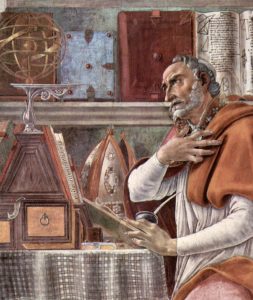 Augustine’s Confessions Video Series!
Augustine’s Confessions Video Series!I’m really happy to be able to invite you to join me in what you might call an online historical theological adventure. Above you’ll find the first introductory video for a series I’m doing on one of the greatest books ever written: Augustine’s Confessions.
The rest of the videos will come at a rate between weekly and monthly. There will be one short video (about ten minutes is my goal) on each of the 13 “books” of the Confessions.
To access them you need to be part of my Patreon group at the level I can “The Education.” It’s designed to be continuing education for pastors or adult education for people who are curious about great texts from the history of Christianity.
The Low DownHere’s how it works:
You sign up to support me in this project on PatreonI choose a topic and post a series of videos (e.g. Augustine’s Confessions)You read the text and watch the videosYou get invited to join the discussion of the text in the comments after each video(When a new series is starting you also get invited to join a weekly small group to discuss the text in real time via Zoom)And while you remain a supporter, you continue to have access to all the videos in the series to use in adult ed classes or your own small groups.
Sound fun? I think it is.
It’s especially for all the people who tell me they miss seminary and the intellectual and spiritual stimulation that comes from reading and discussing important Christian works together.
Previous SeriesInside my Patreon page you’ll find the earlier series I’ve done:
Martyrs of the Early ChurchWindows into Worship in the Early ChurchJustin Martyr’s First ApologyGregory of Nyssa’s Life of MosesCome on over to Patreon. Hasn’t something inside you always wanted a chance to explore one of the greatest books ever written, by the most influential thinker in all of Western Christian history?
Check out my Patreon groupThe post Augustine’s Confessions — New Video Series appeared first on Gary Neal Hansen.
March 2, 2021
The Cleansing of the Temple — Lent 3

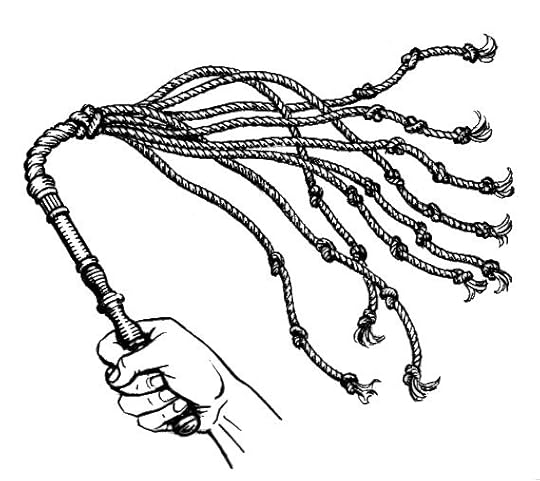 Cat-O-Nine-Tails (public domain)
Cat-O-Nine-Tails (public domain)In Year B, the Gospel for the third Sunday in Lent jumps from Mark to John. The text is John 2:13-22, “the cleansing of the temple.”
It is a strange time to leave Mark behind: Mark tells the same story in chapter 11, but the lectionary never selects it. We read it in Lent, and that’s what makes the move to John odd.
In Mark the cleansing of the Temple happens on Monday of Holy Week, after the Triumphal Entry on Palm Sunday. That’s absolutely a Lenten context. For John’s version we have to turn the pages back to chapter 2, to the very beginning of Jesus’ earthly ministry.Lent — the Cleansing of the TempleIt’s probably easy to see why this story is brought before us in Lent. It’s a season of penitence and spiritual preparation. We need to get ready for the great sacrificial act of Christ on Good Friday, and for the great good news of new life on Easter.
So it’s fitting to tell a story where Jesus goes to the focal point of Israel’s religious life, the Temple, and tells everyone there to get their act in order and treat his Father’s house as a holy place of prayer.
We need to do the same in our own lives. We’re told, after all, that we are temples of the Holy Spirit, that God dwells in us and abides in us, that we carry God’s presence and name. We need to up our game and hallow that Name of his–as we say in the Lord’s Prayer.
“The Jews”John’s treatment of the cleansing of the Temple is a bit longer, and in context it is perhaps less troubling than Mark’s in its treatment of the Jews.
Perhaps. It’s a tough call, actually. Neither evangelist comes out as a shining paragon of toleration and inclusivity.
One probably hears more wincing about anti-semitic elements in John’s Gospel than any of the others. He has this way of poking and blaming and generally negatively naming “the Jews” more than the other Gospels do.
There are three references like this just in our passage:
In verse 13, “The Passover of the Jews was near…”In verse 18, after he’d driven out the animals and the money changers, “ The Jews then said to him, ‘What sign can you show us for doing this?’”Then in verse 20, after Jesus said he’d raise up the temple after three days, “ The Jews then said,‘This temple has been under construction for forty-six years, and will you raise it up in three days?’”Personally I’ve always found these references odd. They strike my ear as more comic than otherwise.
I mean, why “the Passover of the Jews”? Honestly: who else has a Passover?
And who else in the Temple, or in Jerusalem, or anywhere else in Judea would be likely to ask Jesus questions? Of course the questions come from Jews.
And what, I ask you, were Jesus and his disciples? They themselves were Jews.
I don’t blame Jewish people for feeling like they are being blamed here, or being portrayed badly.
And there is nothing but shame on Christianity for the harm done to the Jewish people over the centuries as a result of the New Testament authors being rather, shall we say, ham-handed in their portrayal of the Jews.
But aren’t these references actually kind of ludicrous?
“The Passover…was near”The fact that John portrays the cleansing of the Temple as happening as the Passover approached may make sense of reading this story in a Lenten context. Luke explicitly connects the events of the Passion and Resurrection with the Exodus.
But in a very important way, any event in the Gospels can be fairly read in a Lenten light, as part of the journey to the Cross.
“Making a whip of cords”I don’t quite know what to make of it, but in one small detail John’s portrayal of the cleansing of the Temple is far more dramatic than those in the Synoptics.
In the Synoptics Jesus comes in, without discussion beforehand, and then drives out those who made the Temple a place of commerce. He might have simply walked in from the street and calmly started directing traffic to the exits.
Only in John is the act carefully premeditated. He knew exactly what he had in mind. He took the time to take some lengths of rope and braid them into a weapon.
Then, whip in hand, he attacked.
This detail, I think, is one to keep in mind for all us Protestants who object to the idea that Lent is a penitential season.
We’re happy with a time of reflection.
We’re okay with Lent as a season of sincere prayer.
We might give up something we like — but we don’t want to make it a serious fast.
I think (and I have some evidence from Protestant preaching and conversation on the topic) that Protestants think a penitential season, or a penitential attitude, is associated with skewed assumptions about life and faith. We think it’s “neurotic guilt.”
God loves us, we say, and that’s true enough.God has accepted us with free grace, we say, and that’s true too.But somehow we convince ourselves that because God loves us and accepts us, that God doesn’t have any objection to any of our behavior.That’s a faulty conclusion.
Jesus loves the Jews on the pages of John’s Gospel.Jesus accepts them with free grace too. But Jesus is not the least amused by some of the behavior of some of the people in that community, right there in the place most central to their life of faith.Jesus disliked their behavior so much that he took the time to braid his own cat-o-nine-tails and come after them with violence.
So maybe we too, we who take our lives of faith far less seriously and far less rigorously than 1st century Jews in Jerusalem, should focus our attention this Lent on some sober self-examination.
Just maybe.
“Destroy this temple”I love Jesus’ playfulness with words when he talks to those who questioned him after the cleansing of the temple.
He says,
He’d been dealing with the big building where God’s name dwelt.He spoke of his body, where the second Person of the Trinity dwelt.
Destroy this temple,
and in three days I will raise it up.
John 2:19 NRSV
They mistook his ambiguous reference — and quoted it against him later.
But there is something winsome about his confident casualness in talking in this way, surely knowing that they would misunderstand it.
Or was it a casualness that came from his deeper, truer assessment of the nature of things?
He really was the real temple, after all.
“The scriptures and the word Jesus had spoken”And I love John’s summary comment about the disciples, remembering this event years later:
After he was raised from the dead,
his disciples remembered that he had said this;
and they believed
the scripture
and the word that Jesus had spoken.
John 2:22 NRSV
It is a window into earliest Christianity, before a set of documents was compiled, or even written, that could be thought of as the New Testament, part of the Bible alongside the Law, the Prophets, and the Writings.
Even if John tries to distance himself from “the Jews” here, he shows his own Jewish assumptions that “the scripture” is the Law, the Prophets, and the Writings–what later Christians would call the “Old Testament.”
Jesus’ words are of ultimate importance. John calls him the Word of God made flesh, after all.
He has to lay it right alongside “the scripture.”
But he don’t quite have a name for it yet.
++++++++++++
Preaching this text? If you want a refreshing take on making your sermon both biblical and useful to the people who listen, check out my book Your First Sermon: Getting from Here to Sunday in Five Manageable Steps.
Amazon reviewers consistently say it has great input for seasoned preachers as well as first-timers. Click the affiliate link to check it out on Amazon. 


The post The Cleansing of the Temple — Lent 3 appeared first on Gary Neal Hansen.
February 10, 2021
The Transfiguration — Mark 9:2-9
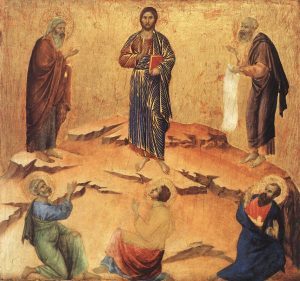
 Duccio di Buoninsegna – Transfiguration (public domain)
Duccio di Buoninsegna – Transfiguration (public domain)This Sunday is “Transfiguration Sunday” in the West, and so in Year B the Revised Common Lectionary gives us Mark 9:2-9. The same text will be one of the options just two weeks from now, on the 2nd Sunday of Lent.
The TransfigurationUnlike last week’s Gospel, this text is one story, focusing on a single remarkable event: Jesus took his three closest disciples up a mountain and they saw him shine with divine glory. The three Synoptic Gospels include the story in very similar terms. John omits it.
As is often the case, in my meditation on this text I am drawn to a number of little details, the twists and turns of Mark’s telling of the tale. I find each of them is ripe for fruitful contemplation — any time a little detail of a passage jars me out of my ordinary train of thought this seems to be the case. And any of them could be the focus of a sermon on this passage.
1. Apart, By ThemselvesI love how emphatic Mark is about the four guys taking some time away from the the rest.
led them up a high mountain
apart,
by themselves.
Mark 9:2 NRSV
Maybe it’s a useful thing to note. The small group of them left the rest behind. On purpose.
Sometimes in churches, especially in small churches, we act as if we can only do things if everybody can come. We labor to make sure that two activities are not planned at the same time. We know the particular people on the finance committee will not want to go to Spring Garden Clean Up Day, but just in case we put the events on different days.
It’s something that can hold a church back from, say, small groups like Bible studies and prayer groups. We think having a particular small group, something others aren’t invited to, is a problem — it’s “exclusive.” And we don’t want that.
But here is Jesus, choosing these three friends to join him in this unique experience. The others just aren’t invited.
Maybe the others were down at the foot of the mountain grumbling about being left out.
Personally, I doubt it.
Jesus, as a leader, chose particular people to share particular experiences.
Leaders need to do the same thing today. There is wisdom in creating all kinds of focused small groups, and churches can build health by having whole networks of small groups. That’s how close relationships grow, and where real learning happens.
2. He Was TransfiguredMark uses an important turn of phrase in describing the central event of the Transfiguration.
And he was transfigured before them
Mark 9:2 NRSV
Notice that? He declares that the transfiguration actually happened. He was transfigured.
And he makes it something that happened to Jesus.
It’s kind of too easy for people in our era to describe what happens as “a vision” — something that happens to the eyes, or in the perception, or the memory, of the disciples. I’m pretty sure I’ve described it this way myself.
But if we describe the transfiguration as something that changed the way the disciples saw, then we minimize it.
The text, on the other hand, tells us that Jesus was really changed.
Yes, the disciples saw “behind the curtain,” and got a glimpse of Jesus’ divine glory. But Mark wants us know that the curtain itself was actually drawn back.
They didn’t have a flash of insight or a visionary experience.
Jesus showed them something, revealed something about himself that he generally kept hidden.
If I have a vision, then you could be standing right beside me but see nothing.But if Jesus really was transfigured, then you had been there you would have seen it too.I’m not going to assert any big implications of this. I just think we need to contemplate it and preach it as something real — albeit something very mysterious.
Ponder what you would see if Jesus pulled the curtain back today.
3. Jesus, Elijah, and MosesOne thing the three disciples saw was blinding light. Jesus himself was transfigured, and even his clothes shone.
The other thing they saw was that Jesus was chatting with friends — ones they hadn’t seen there a moment before.
And there appeared to them
Elijah
with Moses,
who were talking with Jesus.
Mark 9:4
I notice the language leans a tad more toward the visionary here. That is, there’s a potential contrast between “he was transfigured” and “there appeared to them.” But the contrast is not strong, and may not be intended at all. Either they “appeared to them” in a vision, or they “appeared to them” because they were actually there.
I lean toward the “actually there” theory. Visions are usually just for one person.
I used to feel rather befuddled by Jesus’ choice of company at the transfiguration. Why Moses and Elijah?
Moses is the lawgiver, and it sure seems like in Jesus’ time Elijah was the prototypical prophet.
(I would have picked Isaiah as the prototypical prophet, reading the OT through the lens of the NT theology, but in the Gospels they had a real expectation around Elijah returning. Elijah was the key player.)
When Luke tells the story he gives a clue to another reason. Luke says the three of them were talking about Jesus’ upcoming “exodus.”
The original Exodus, of course, was the parting of the Red Sea so the Israelites could escape slavery in Egypt. Less prominent in Christian memory is the fact that Elijah also parted waters, making it possible to pass through a river dry shod.So as well as “Law, Prophets, and Gospel,” these three are all “exodus” figures in one way or another, sharing a symbolic image and language for how salvation comes about for God’s people.
Mark leaves it a mystery. Just three great leaders holding the original summit meeting.
4. Peter’s Big IdeaThough it is not especially inspiring, I’ve always loved Peter’s role here.
Then Peter said to Jesus,
‘Rabbi, it is good for us to be here;
let us make three dwellings,
one for you,
one for Moses,
and one for Elijah.’
He did not know what to say,
for they were terrified.
Mark 9:5-6
Scared? Confused? Peter’s solution: Say something — anything.
Propose a construction project on top of a mountain.
It seems kind of dumb, but there may be some wisdom there.
No, not in the idea of building mountain chateaux for the three great leaders.
Rather wisdom in Peter’s strategy for dealing with a baffling situation: Say something — anything — with no fear of sounding stupid.
By saying something, he got a response. Clarity came directly from God.
Would God have spoken if Peter hadn’t been the catalyst to conversation?
So say something when you’re confused, whether to God in prayer or to others who share your plight. Don’t just sit there and cower. Talk about it.
You might just hear an answer.
5. ListenThen there is the marvelous message from the cloud of God’s presence:
This is my Son,
the Beloved;
listen to him!
Mark 9:7
It’s a tad different from what Jesus had said to these guys back in chapter 1.
Back then, Jesus asked them to follow. Here, God asked them to listen.Both are good. But for people who have been trying to follow Jesus for a few pages of their lives, the call to listen seems pretty wise.
We get convinced, after a while, that we’ve heard it all. We tell ourselves we know exactly where Jesus is taking us.
But I’ve noticed that people claiming to be following Jesus are doing stuff he actually said not to do. (Actually I’ve noticed it a lot recently)
Maybe if all of Jesus’ followers made it a point to be Jesus’ listeners, our following would look a bit more … Christ-like.
6. Tell No OneThen at the end, there’s the mystery.
They’ve just seen the most amazing thing ever, and heard a direct message from heaven, and what does Jesus say?
he ordered them to tell no one about what they had seen,
until after the Son of Man had risen from the dead.
Mark 2:9 NRSV
Well that’s kind of rotten.
It would seem a lot nicer if Jesus let them brag, I mean humbly tell, about it when they met up with the rest of the gang.
If the reading went on one verse more we would know that the request left them confused about what “rising from the dead” meant. Maybe the whole experience was to get them thinking about that question — after all, he had told them in chapter 8 that he would die and rise from the dead, but it clearly didn’t stick.
Jesus had his own sense of when his own big secrets should be revealed. This image of the transfiguration was to be kept secret for now.
But I suspect that it was also good for the disciples to have to keep quiet about something so profoundly moving. When you and I have profound experiences of God’s presence, we are also well advised to be circumspect in whom we tell and when we tell it. It builds humility. And it holds dear what is truly precious.
++++++++++++
This year Mark is the main Gospel in the Revised Common Lectionary. Want a great way to creatively engage with each Sunday’s text? Want something to keep your kids on-topic during the sermon on Sunday? Try my Illuminate-You-Own Gospel of Mark. Each story is on a page of its own, with a blank facing page for doodles, prayers, sermon notes, or journal entries. Click the image below to check it out on Amazon. (It’s an affiliate link.)
[image error]The post The Transfiguration — Mark 9:2-9 appeared first on Gary Neal Hansen.
February 1, 2021
A Day in the Life of Jesus — Mark 1:29-39
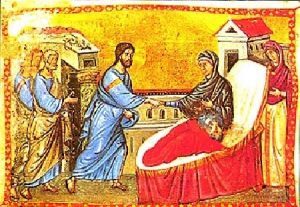
 Mt Athos, Healing Peter’s Mother-in-Law (public domain)
Mt Athos, Healing Peter’s Mother-in-Law (public domain)For Year B, on the Fifth Sunday after Epiphany, the Revised Common Lectionary Gospel text is Mark 1:29-39. It is more “a day in the life of Jesus” than on one of those texts that makes a single, unified point.
A Day in the Life of JesusThat is to say, it is an amazing series of moments, any one of which is food for the soul, whether you are meditating on your own or preparing a sermon.
It starts one afternoon, and continues the following morning — about 24 hours, give or take. We’re still in chapter 1, so Mark’s Gospel is just getting rolling. But by the time our text picks up the story, Jesus has been baptized, has been tempted, has gathered his first disciples, has taught in a synagogue, and has cast out a demon.
Simon’s Mother-in-LawAfter a morning of ministry, Jesus and friends headed to “the house of Simon and Andrew,” a destination I’d never really thought about before today. This was, it seems, the home of an extended family.
When they got there “Simon’s mother-in-law was in bed with a fever.” Which, the alert reader will notice, means that somewhere in that house Simon had a wife. Which, in turn, will prompt the alert reader to conclude that Simon (aka the Apostle Peter), the first Bishop of Rome (aka “Pope”) was married.
That’s not really much of a preachable observation, but it is interesting to me as a historian. In the year 325 the Council of Nicaea will make it a stated policy that bishops cannot be married. This remains the policy of the Orthodox East and the Catholic West to this day, with the Catholic side expanding the requirement of celibacy to all of its priests as well.
So it becomes an example of the Church’s canons, or laws, going beyond what was clearly the lived practice of the apostolic era. For some that’s a scandal. But for others that’s the Holy Spirit guiding the Church in wisdom. For me? It’s just kind of interesting.
She Began to Serve ThemWell the first thing Jesus did when he heard that Peter’s wife’s mom was sick was he went and healed her. Well done. That’s his first healing miracle in Mark’s Gospel.
More interesting to me is Mark’s testimony to what happened next:
Then the fever left her,
and she began to serve them.
Mark 1:31 NRSV
I suppose you could take that as evidence of a patriarchal culture where women were expected to serve the men.
I prefer to take it as evidence that when Christ heals someone, the healing goes deeper than curing a superficial fever. Jesus is intent on bringing us around to the life we are intended to live — a life where the greatest are the servants of all.
Like Jesus, you know?
The Whole City Was GatheredOne of the things I have long found fascinating in Mark is his portrayal of Jesus’ popularity. He spends a great deal of time being swarmed by people who want him to heal them or help them in some other way.
We get the first example of that in this text.
Jesus has preached precisely one sermon, cast out precisely one demon, and healed precisely one mother-in-law. But the word got out and man, did people want to get some of that for themselves.
That evening, at sundown,
they brought to him all who were sick
or possessed with demons.
And the whole city
was gathered around the door.
Mark 1:32-33 NRSV
It’s quietly comical, I think. They bring him absolutely everyone in town who is sick or demon possessed.
And by the time they reach the end of that list they bring precisely… every single person in town.
Maybe that’s just Gospel honesty: if everyone who needs healing or spiritual restoration were to come to church this Sunday, the place would be bursting at the seams. Every person in every town fits that description.
ManyNow pay careful attention to how this first public example of Jesus’ healing ministry unfolds:
And he cured
many
who were sick with various diseases,
and cast out
many
demons; …
Mark 1:34 NRSV
Not “all.” Just “many.”
Okay, you and I and any nurse or physician would be pleased as punch if we could spend the day walking the COVID ward of the local hospital and curing “many.”
Hey, it would be nice if we could cure “any.”
But with Jesus we expect him to heal everybody.
If you look you’ll find other passages where Jesus heals “all.” But not here. It’s a day in the life of Jesus, and some days apparently are better than others.
So don’t expect Jesus to solve every single problem for you and your congregation. He didn’t always do it when he was walking around in the flesh either.
Everyone Is Looking for YouWhen he’d finished that long evening’s work, Jesus went to bed. But he got up early. Why?
Well to pray, of course. That’s the pious observation. I’ve mentioned it many times in sermons and in writing.
But also to escape.
Maybe the two go together.
It’s easy for people in ministry to feel rather trapped by the demands of others. I’ve certainly heard pastors say during this pandemic that they’ve had to work harder than they ever have before. And I hear tell that many are finding it hard to do the obviously healthy things, like taking a day for sabbath rest.
Well, my friend, Jesus had a lot of demands. An entire town showed up in the front yard of his Airbnb. Every single person among them wanted to be healed. He knew he needed a break.
So off he went, without telling anyone where he was going. He had to go out and grab that time of prayer to restore his own sanity and equilibrium.
Make a day in the life of Jesus the role model for a day in your own life. Daily prayer, my friend, and weekly sabbath rest.
And of course he was right. His disciples put out an APB, and when they found him they told him
Everyone is searching for you.
Mark 1:37
All those people, the entire town, who came to his doorstep the night before? They were back. Every one of them.
Good thing he got away — instead of thinking he should always be there for every person to meet their every need and expectation.
(I tremble when I hear pastors say boastfully that they are “on call 24/7.” Jesus didn’t do it. It’s not the path to health or success.)
Let Us GoWhen the disciples found him to bring him back to do some more healing, what did he say?
Let us go on to the neighboring towns…
Mark 1:38 NRSV
Jesus actually had no intention of sticking around Capernaum to live at the beck and call of every needy person in town. Time to get the heck out of Dodge.
Take note of why he left this town where they wanted him so desperately:
It was
…so that I may proclaim the message there also;
for that is what I came out to do.
Mark 1:39 NRSV
Going to one town and staying there was not his mission.
Traveling far and wide was his mission, teaching about the kingdom and then healing people as an example of the kingdom’s work.
Jesus went away to serve other communities because, as he said, “that is what I came out to do.”
Of course that doesn’t mean we are all called to leave the places we are wanted and needed. Some of the best pastors and some of the healthiest ministries, are long term in one community.
But whether we need to stay, or whether we need to go, we need to practice the same kind of discernment Jesus did here.
During a day in the life of Jesus, how did he decide what to do?
He did what fit his mission.
That is what I came out to do.
What did you come to do?
What’s your mission?
Need any course adjustments to get back to it?
++++++++++++
This year Mark is the main Gospel in the Revised Common Lectionary. Want a great way to creatively engage with each Sunday’s text? Want something to keep your kids on-topic during the sermon on Sunday? Try my Illuminate-You-Own Gospel of Mark. Each story is on a page of its own, with a blank facing page for doodles, prayers, sermon notes, or journal entries. Click the image below to check it out on Amazon. (It’s an affiliate link.)
[image error]The post A Day in the Life of Jesus — Mark 1:29-39 appeared first on Gary Neal Hansen.
December 21, 2020
The Presentation of Jesus — Luke 2:22-40
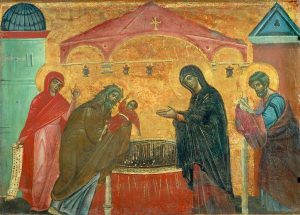
 Guido Da Siena – Presentation of Jesus at the Temple (public domain)
Guido Da Siena – Presentation of Jesus at the Temple (public domain)On the First Sunday after Christmas, the Revised Common Lectionary offers us the text known as “The Presentation of Jesus.” It’s Luke 2:22-40 and comes in four distinct scenes.
The Presentation
The scene is set for the Presentation with references to the Holy Family and the law of God.
We tend to picture just three people: Mary, Jesus, and Joseph. Tradition has Joseph older, a widower, with children from his first marriage who will, in the Gospels, be called Jesus’ siblings.
The number is not so important. The text emphasizes their Jewish faithfulness. With no fewer than three references to the requirements of the law, they are shown coming to the temple, ready to observe the rites of purification.
It is easy to forget their Jewishness somehow. But this Jesus is the Jewish Messiah, born to a Jewish family in a Jewish land, practicing the Jewish religion. That’s our savior.
The Song of Simeon
To me the heart of the Presentation is the Song of Simeon:
Master, now you are dismissing your servant in peace,
according to your word;
for my eyes have seen your salvation,
which you have prepared in the presence of all peoples,
a light for revelation to the Gentiles
and for glory to your people Israel.
Luke 2:29-32, NRSV
I really love this text. I’ve said or sung it so many times in Episcopal Evening Prayer or Compline services, on retreat at Roman Catholic Benedictine monasteries, and at Wednesday and Saturday Orthodox Vespers services.
And I love the story around it:
Old Simeon, promised by the Spirit (he was sure it was the Spirit… it couldn’t have been his imagination, just a longing heart’s pious wish…) that he would live to see the promised Messiah.
But he was so very old. He felt like it was time to go, to leave this world for — well, for whatever it was that God had in store for those who loved and served him. He was tired, so very tired. He was weak, and he was ill. Would the promise be fulfilled?
Then one day, a day like any other, really, into the Temple walks a family: young mother, older man, babe in arms. Maybe some older kids.
Somehow he knew this was The One. (It had to be… he could just tell… there was that nudge inside, that whisper again…) This baby was the Messiah he had waited so long to see.
So he approached them. He reached out to the woman, wordlessly asking to hold her baby. She didn’t turn away — maybe she knew that this stranger was alright, someone who would be safe with the child. She let him take the boy in his arms.
The look on his face seemed to communicate a blessing. He turned his eyes to heaven and — he sang.
He sang about the end of his life; that he had fulfilled his purpose somehow, having seen and held this child. It sounded as if God were giving him permission to die. But what had he seen?
“My eyes have seen your salvation” he sang. Jesus, as an infant in swaddling cloths, is salvation. Not just Simeon’s personal salvation. God’s gift of salvation, coming to all the world, as the song goes on to say.
Again in this song we have the theme of all Luke’s songs: salvation is not something that will start 33 years in the future, when Jesus is grown, has taught and healed and called disciples, when he finally is crucified. In the very fact of Jesus being born, salvation has come.
In this little child, God is with us. The holy God, the very Image of the Father, has taken up human flesh, become truly human in the womb of Mary. Now human flesh, all humanity, begins the process of being restored to the image of God, renewed in the very likeness of God.
The process is not complete in any of us.
But it has begun for all of us.
And it cannot be stopped, or assumed to be nullified, in even one of us.
I pray for the continued effect of this salvation in me, in my family, in the Church, and throughout the world. I pray for the ability to see and know what Simeon saw and knew and sang of so long ago.
In contemplation I gaze at this child, at the scene with this old man, and at the God who answers my prayer.
Simeon’s Warning
But the Presentation doesn’t end with the Song of Simeon. He pauses to give Mary a bit of prophetic insight.
Jesus, this tiny baby, will be like a big old rock in the path — a rock of ages, perhaps, Some will step up higher by standing on him, and others will trip and fall over him.
And Mary herself gets a bit of a warning. She had just let the excitement of new motherhood take root, displacing the fear and trembling of being pregnant via the Holy Spirit. Now this strange man in the temple tells her a sword will pierce her soul because of her baby boy.
She probably wondered if she should have let the old guy hold Jesus a minute or two before.
The Prophet Anna
The last part of the Presentation is so very lovely that it’s a shame it doesn’t get more attention.
It turns out Simeon is not the only elderly person hanging out in the Temple. Anna, an 87 year old prophet, is basically living there.
She worships. She fasts. She prays. She never leaves.
I’d say she embodies those lines in the Psalms, where it says that
Even the sparrow finds a home,
and the swallow a nest for herself,
where she may lay her young,
at your altars, O Lord of hosts,
my King and my God.
Psalm 84:3 NRSV
For a day in your courts
is better than a thousand elsewhere.
I would rather be a doorkeeper in the house of my God
than live in the tents of wickedness.
Psalm 84:10 NRSV
Surely goodness and mercy shall follow me
all the days of my life,
and I shall dwell in the house of the Lord
my whole life long.
Psalm 23:6 NRSV
I’m a little peeved that Luke didn’t record any of her actual words. All he says is that she
…began to praise God
and to speak about the child
to all who were looking for the redemption of Jerusalem.
Luke 2:38 NRSV
I bet she sang.
I mean everybody here sang. Luke 1-2 is basically a musical to which the tunes have been lost.
Gabriel sang.
Mary sang.
Zechariah sang.
When Elizabeth spoke to Mary it really sounds a bit like a song too.
Old Simeon sang up a storm.
But Anna? No song.
She just heads out from the temple to do the work of a prophet at 87.
Personally? That makes me want to sing.
++++++++++++
This year Mark is the main Gospel in the Revised Common Lectionary. Want a great way to creatively engage with each Sunday’s text? Want something to keep your kids on-topic during the sermon on Sunday? Try my Illuminate-You-Own Gospel of Mark. Each story is on a page of its own, with a blank facing page for doodles, prayers, sermon notes, or journal entries. Click the image below to check it out on Amazon. (It’s an affiliate link.)
[image error]
The post The Presentation of Jesus — Luke 2:22-40 appeared first on Gary Neal Hansen.
December 15, 2020
The Annunciation — Luke 1:26-38 on Advent 3
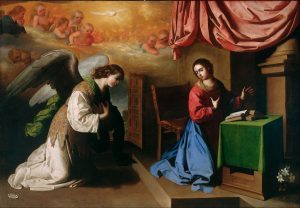
 Franciscode Zurbaran “The Annunciation” (public domain)
Franciscode Zurbaran “The Annunciation” (public domain)On the Third Sunday of Advent, Year B of the Revised Common Lectionary gives us Luke 1:26-38. It is the story of “the Annunciation,” nine months before Christmas. But we are in December, chronologically only a week-and-a-half before Mary will give birth.
It’s all good. Advent is an excellent time to think about the promise of Jesus birth given to the Virgin Mary.
The Annunciation and Lectio Divina
I’ve written about this passage before, in reference to March 25 on which the Church celebrates the Annunciation. But I’ve also just spent a week dwelling in this text with my Advent class on classical Lectio Divina. So I decided that for a Monday(ish) meditation, I would bring in a slightly edited version of the reflections I made throughout that week.
Day 1: Be Not Afraid
What struck my curiosity first, here and in the message to Zechariah a few verses earlier, was the first phrase of the angel’s greeting:
Don’t be afraid!
I think of this as the standard angelic opener. And I always figure it was needed: imagine a stranger showing up in your living room without knocking at the door, in clothes so bright with God’s reflected glory that they shone like the sun. It would be… startling, to say the least.
I went to Bible Gateway and searched the phrase in the NRSV. It occurs 67 times, counting OT, NT and a few from the Apocryphal books. When you start reading through them, it’s like the high-points of the Biblical story.
God says these words to patriarchs and prophets
Midwives speak these words to women in labor
Prophets speak these words to Israel in exile
Jesus says these words to crowds and disciples.
I’m led to think about this as a core element of God’s ongoing guidance to humanity. Of course it is a bit ludicrous to think you can boss your fears into submission. But the gist of the meaning, in text after text, is
You actually do not NEED to be afraid. God is with you. God is acting for your good and the worlds’s good. You can let go of your grasping, clenching response to troubling circumstances.
As I spent a couple minutes meditating on the verse, repeating the words over and over, my mind went to a good topic of prayer: that the world, beset by a pandemic, an economic crisis, and numerous nations with irrational authoritarian leaders, might hear the call: “Do not be afraid.” Dear God help us let go of the anxiety and walk with you through the darkness into the light.
Day 2: Favor with God
What captures my attention today is the words to Mary, which we Protestant types tend to gloss over. After the initial “Hail Mary,” as it were, Gabriel says
You have found favor with God.
I’m not diving into the Greek, but I find that the only other instance of the phrase “favor with God” in the NRSV is also from Luke’s pen, in the Book of Acts, where Stephen, the deacon and first martyr, is reciting Israel’s history and says that king David found favor with God. The NIV has the phrase here and in a description of young Jesus finding favor with God and people.
That is mighty fine company for Mary to find herself in.
There’s David, the most lauded king of Israel, to whom was promised a perpetual reign and the the eventual Messiah.
Then Jesus, the incarnate Son of God, the Messiah promised to David and his line.
And finally Mary. Young. Innocent. On the cusp of adulthood, betrothed but not married.
There she is, praised by the Angel Gabriel in words otherwise used only for the King and the Lord.
Astonishing, really. Why are we Protestants so hesitant to sing of her and to be in wonder at the miracle brought about through her?
Day 3: Forever
Today I was at first intrigued by the word “forever” in the Annunciation of Mary’s child’s reign.
When I looked to Calvin’s commentary I found that he spent more attention on the promise that Jesus would reign “over the house of Jacob.” And why not? It is a bit of an odd claim, since the Church quickly became majority Gentile.
Here’s Calvin’s take:
By a new and wonderful adoption, God has admitted into the family of Jacob the Gentiles, who formerly were strangers; though in such a manner that the Jews, as the first-born, held a preferable rank…
I was glad to see Calvin preserved Paul’s priority on the continued calling of the Jews, or their eventual restoration.
When it came to my word “forever” Calvin reminds us that this was the promise to David himself and his heirs, though historically the visible fulfillment has been rather up and down. Mostly down. He suggests that the real fulfillment of the literal promise is in heaven.
Day 4: The Power of the Most High
Today I’m looking at Gabriel’s explanatory words to Mary at the Annunciation of this exceedingly unlikely thing: that she, a virgin, would supposedly be pregnant.
The Holy Spirit will come on you, and the power of the Most High will overshadow you.
Simple as that. As Gabriel explained about the pregnancy of Mary’s aged relative Elizabeth,
For nothing will be impossible with God.
The thing that interested me was the use of the word “power” here. It seems potentially troubling. Think of a situation where someone uses their “power” to cause someone else to become pregnant…
So I did a little search of the word “power” in Luke. In the NRSV it occurs 20 times in his Gospel.
Most of them are references to Jesus’ miraculous works, and especially his miracles of healing.
Then others are about the effect of the Spirit’s presence in someone’s life — usually in Jesus.
Another group is less sacred power — those “powerful” cast from their thrones in the Magnificat, the “power” of darkness, and someone in a parable getting “royal power.”
The use of power related to God seems tied to his goodness, fitting his character. God’s power works toward healing the brokenness in people’s lives.
What if instead of worrying about “abuse of power” here, I thought differently about God’s powerful work of making Mary pregnant. Could it be an example of healing and redemption?
It powerful — but there was no abuse. After all, it happened only on her agreement:
Here am I, the servant of the Lord; let it be with me according to your word.
And so…
I really love my Advent lectio divina class. My experience of these texts is different every year. Maybe next time around you’ll want to join in! (Click here to get on the waiting list.)
++++++++++++
This year Mark is the main Gospel in the Revised Common Lectionary. Want a great way to creatively engage with each Sunday’s text? Want something to keep your kids on-topic during the sermon on Sunday? Try my Illuminate-You-Own Gospel of Mark. Each story is on a page of its own, with a blank facing page for doodles, prayers, sermon notes, or journal entries. Click the image below to check it out on Amazon. (It’s an affiliate link.)
[image error]
The post The Annunciation — Luke 1:26-38 on Advent 3 appeared first on Gary Neal Hansen.
December 7, 2020
Not the Light — John 1:6-8, 19-28
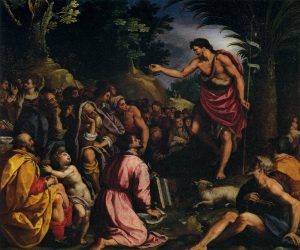
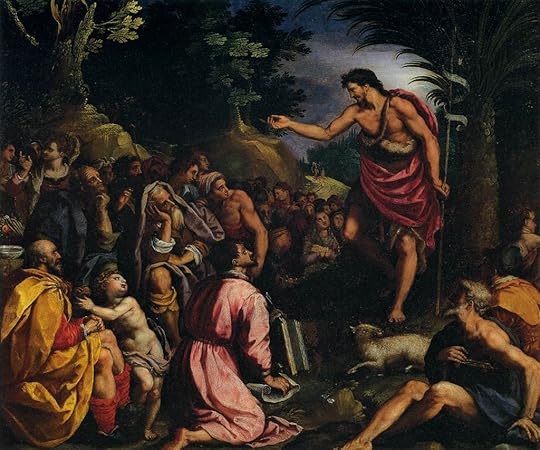 Alessandro Allori, The Preaching of St John the Baptist (public domain)
Alessandro Allori, The Preaching of St John the Baptist (public domain)The discussion of John the Baptist as “not the light” but rather “a witness to testify to the light” is missing its context. In year C, the Gospel for the third Sunday of Advent is John 1:6-8 and 19-28, the parts of Gospel’s prologue about John the Baptist, and leaving out the parts directly about Jesus.
Reading the prologue to John in its entirety though, it is quite clear: The Word, who came and dwelt among us, is the light, and the darkness can not overcome it. That is a bit of good news we desperately need at the moment, but the Lectionary puts it off until Christmas, giving us the Advent ministry of John the Baptist instead.
John 1:6-8, 19-28
John the Evangelist brings John the Baptist into the story here for the first time.
Perhaps he thought we would mistake the Baptist for the Messiah, or perhaps there were those still in the world who followed John the Baptist but not Jesus. It certainly happened in the Book of Acts, and it seems there remained or arose sects of exactly that nature even into modern times.
Not the Light
Even without that motivation from his imagined readers, John the Evangelist finds this question among the people in John’s own day. He shows the leaders of the Jewish religious community in Jerusalem sending emissaries to ask John exactly this question — or rather these questions.
Who are you?
John 1:19 NRSV
Are you Elijah?
Are you the prophet?
John 1:21 NRSV
Who are you? Let us have an answer for those who sent us.
What do you say about yourself?”
John 1:22 NRSV
John is clear. Not one of these is a title he’s willing to claim.
But He Is Elijah — Sort of
Perhaps I should stop and address the fact that by Jesus’ later testimony John was actually wrong about this. Jesus said John was, in fact, the return of Elijah they had come to expect (Matthew 11:13-14). There is a message to us here: It is quite possible to be exactly who you are and who God is calling you to be with having the slightest clue about the fact.
But that is not to the point here.
One Crying in the Wilderness
John the Baptist wanted them, and us, to know that he was not the “light,” not “the Messiah,” not “Elijah,” just plain old John from the hill country.
Finally he tossed them a clear answer though, and his self-understanding is revealing:
I am the voice of one crying out in the wilderness,
‘Make straight the way of the Lord,’”
as the prophet Isaiah said.
John 1:23 NRSV
Notice that the NRSV ends John’s quotation before the explicit citation of Isaiah. The Baptist might as easily have spoken the words “as the prophet Isaiah said.” He surely knew he was quoting Isaiah.
The fact that John explicitly quoted this passage of Isaiah shows that despite all his denials, he understood himself as functioning prophetically, in preparation for the one he might have affectionately referred to as “Cousin Messiah.”
Maybe that casts doubt on all his denials. Or maybe he just had a very specific understanding of what Elijah’s return would look like. Hard to say.
How Does One Preach This?
I think the tendency in preaching this text is to take that quotation from Isaiah and run with it, turning it into a sermon on the straight highway in the desert, the rough smoothed out, etc. — our Advent preparation.
Or one can find one’s sermon dwelling on John’s submission to Jesus, his affirmation that he isn’t worthy to untie Jesus’ sandals — another aspect of a proper Advent attitude.
Both are fine. Very reasonable emphases in this text.
“Among You Stands One”
What catches my eye is John the Baptist’s testimony about where Jesus was to be found. It’s easy to miss.
The priests and the Levites came out to question John, but they were specifically sent from the Pharisees.
Now they had been sent from the Pharisees.
John 1:24 NRSV
See?
So here’s this group of Pharisees, a scribe-and-Levite subset of the Pharisees, sent to question the Baptist. Where is the Messiah to be found?
Among you
stands one
whom you do not know,
the one who is coming after me…”
John 1:26-27 NRSV
We usually set Jesus against the Pharisees, as if they are the bad guys, persecuting innocent Jesus. We mock them as excessively legalistic, strainers out of gnats and swallowers of camels.
But Jesus was “among” them. He was standing there in the midst of the Pharisees —whether in the group who came out that day, or in the main body back in Jerusalem.
Did you ever notice that Jesus actually spends a lot of time with Pharisees in the Gospels? He eats at their houses, they hang around when he’s teaching. He was “among” them.
I think we forget that to our peril. Jesus wasn’t “outside” the Pharisees, casting his accusations and critiques and sarcastic barbs. Jesus was speaking to his own community — yes, a community that became increasingly separate by the end, but which he worked hard to love toward the Kingdom.
++++++++++++
This year Mark is the main Gospel in the Revised Common Lectionary. Want a great way to creatively engage with each Sunday’s text? Want something to keep your kids on-topic during the sermon on Sunday? Try my Illuminate-You-Own Gospel of Mark. Each story is on a page of its own, with a blank facing page for doodles, prayers, sermon notes, or journal entries. Click the image below to check it out on Amazon. (It’s an affiliate link.)
[image error]
The post Not the Light — John 1:6-8, 19-28 appeared first on Gary Neal Hansen.



